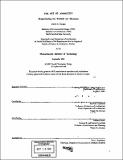The art of ambiguity : (experiencing the Kimbell Art Museum)
Author(s)
Sledge, David C. (David Christopher), 1968-
DownloadFull printable version (36.16Mb)
Alternative title
Experiencing the Kimbell Art Museum
Other Contributors
Massachusetts Institute of Technology. Dept. of Architecture.
Advisor
Stanford Anderson and William Porter.Kahn's design methodology, and second, offer alternative evaluations of the Kimbell Art Museum that include a wide palette of design attributes which bridge the gap between the building and its experience, the tangible and intangible, or to use Kahn's words- the measurable and unmeasurable.
Terms of use
Metadata
Show full item recordAbstract
This thesis examines the Kimbell Art Museum in Fort Worth, Texas, designed and executed between 1966 and 1972 by the architect Louis I. Kahn. This study responds to a series of design related questions raised in the author's mind upon visiting the Kimbell museum on June 22, 2000. The work will evaluate the buildings' major design elements, beginning with the overall site and building organization, and end with the relationship between structure, space and natural light. The building is documented with numerous photographs taken during my visit to illustrate its experiential aspects. This study examines how the Kimbell Art Museum prompts 'readings and re-readings,' associations, symbolisms, and meanings that may initially appear elusive, contradictory or even obscure. My analysis suggests that Louis Kahn designed the Kimbell to generate obscure readings, or to be more precise, he utilized ambiguous design features capable of being understood in two or more possible senses. My analysis also raises questions such as, 'What types of ambiguity are employed in this museum, and why?', and 'How does the Kimbell Art Museum as both building and experience compare to Kahn's stated design goals?' The lens through which this examination takes place is my own experience of the building, tempered by an examination of the building's documentation compared to what Kahn wrote, sketched and built. This project aims to offer plausible insights into the building'S numerous, seemingly ambiguous design features. The process of reading and re-reading the Kimbell reveals elusive aspects of the building that to date, have not been adequately considered and articulated. The object of this study is twofold: first, enhance understanding and appreciation of Louis 1.
Description
Thesis (S.M.)--Massachusetts Institute of Technology, Dept. of Architecture, 2001. Page 135 blank. Includes bibliographical references (p. 131-133).
Date issued
2001Department
Massachusetts Institute of Technology. Department of ArchitecturePublisher
Massachusetts Institute of Technology
Keywords
Architecture.